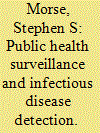|
|
|
Sort Order |
|
|
|
Items / Page
|
|
|
|
|
|
|
| Srl | Item |
| 1 |
ID:
107462


|
|
|
|
|
| Publication |
2011.
|
| Summary/Abstract |
An overview of available literature on the use of protective facemasks by children for protection from respiratory infectious agents reveals relatively few articles dealing specifically with the topic, despite their use during recent outbreaks (eg, severe acute respiratory syndrome, pandemic influenza). Little is known about the physiological and psychological burdens imposed by these devices and a child's ability to correctly use and tolerate them. This article focuses on the myriad issues associated with protective facemask use by children in the hope of educating public health personnel, healthcare professionals, and families on their limitations and associated risks, and in the hope of fostering much-needed research.
|
|
|
|
|
|
|
|
|
|
|
|
|
|
|
|
| 2 |
ID:
145953


|
|
|
|
|
| Summary/Abstract |
Emerging trends suggest a more inclusive and collaborative approach to addressing international infectious disease issues, but without an overarching governance structure and judicial forum in place, outcomes will remain suboptimal. This essay outlines and analyzes several initiatives currently underway and proposes a new comprehensive global governance structure for infectious disease. This proposed structure has built-in incentives for states—from both the developed and developing world—to meet their regulatory obligations and integrates the myriad non-state actors operating in this space, including NGOs and the private sector. It also incorporates an adjudicative body that is able to enforce compliance and resolve issues of contention. Lastly, this essay identifies innovative funding mechanisms and contemplates the venue best suited to host and administer this new global governance structure for infectious disease with a focus on UN-based models.
|
|
|
|
|
|
|
|
|
|
|
|
|
|
|
|
| 3 |
ID:
177076


|
|
|
|
|
| Summary/Abstract |
This essay examines the historical nature of the Novel Coronavirus as an epoch-making turning point in history. It compares and contrasts the current and a previous pandemic and the response by contemporary and earlier societies, respectively. Penned in May 2020 and published in the Japanese-language journal CHUO KORON (July 2020 special issue), this essay is perhaps the final work by renowned author, playwright, literary critic, and philosopher Yamazaki Masakazu who passed away on August 19, 2020.
|
|
|
|
|
|
|
|
|
|
|
|
|
|
|
|
| 4 |
ID:
102007


|
|
|
| 5 |
ID:
126248


|
|
|
|
|
| Publication |
2012.
|
| Summary/Abstract |
In 2002 it was decided to establish laboratory facilities in Denmark for diagnosing agents associated with bioterrorism in order to make an immediate appropriate response to the release of such agents possible. Molecular assays for detection of specific agents and molecular and proteomic techniques for identification of bacteria were introduced as part of the program. All assays and techniques were made accessible for use in diagnosing patients, even when an intentional release was not suspected. Medical expertise on different diseases was established at the department as an integrated part of the program. The analyses included PCR assays for specific bacteria, identification of isolated bacteria by DNA sequencing, detection and identification of bacteria in clinical sample material by universal bacterial PCR and DNA sequencing, and identification of bacteria by mass spectrometry. The established analyses formed a basis on which a series of further developments was built. In addition to reducing the time for obtaining diagnoses and improving the accuracy of diagnosis of individual infected patients, the analyses provided new knowledge on the frequency and distribution of some bacterial infections, including Q fever, tularemia, trench fever, brucellosis, and melioidosis. The implementation of an antibioterrorism program in a clinical diagnostic setting improved the diagnostic possibilities for patients in Denmark and provided new epidemiologic information. It also introduced a number of diagnostic assays for bacterial infections not associated with bioterrorism that are difficult to culture or identify.
|
|
|
|
|
|
|
|
|
|
|
|
|
|
|
|
| 6 |
ID:
114220


|
|
|
|
|
| Publication |
2012.
|
| Summary/Abstract |
Networks are often heralded as a promising strategy of global governance. This article examines the challenges encountered in managing one relatively successful network-the Global Outbreak Alert and Response Network (GOARN). Over the past decade, this international network of public and private institutions has played a major role in organizing the global response to infectious disease outbreaks around the world. Despite its successes, GOARN confronts difficult challenges in balancing performance objectives with the goals of maintaining and developing the network. The imperative to integrate closely into World Health Organization (WHO) operations makes it difficult for GOARN to balance its obligations to the WHO with the need to maintain and cultivate its role as an independent network.
|
|
|
|
|
|
|
|
|
|
|
|
|
|
|
|
| 7 |
ID:
126128


|
|
|
|
|
| Publication |
2012.
|
| Summary/Abstract |
Emerging infectious diseases, such as HIV/AIDS, SARS, and pandemic influenza, and the anthrax attacks of 2001, have demonstrated that we remain vulnerable to health threats caused by infectious diseases. The importance of strengthening global public health surveillance to provide early warning has been the primary recommendation of expert groups for at least the past 2 decades. However, despite improvements in the past decade, public health surveillance capabilities remain limited and fragmented, with uneven global coverage. Recent initiatives provide hope of addressing this issue, and new technological and conceptual advances could, for the first time, place capability for global surveillance within reach. Such advances include the revised International Health Regulations (IHR 2005) and the use of new data sources and methods to improve global coverage, sensitivity, and timeliness, which show promise for providing capabilities to extend and complement the existing infrastructure. One example is syndromic surveillance, using nontraditional and often automated data sources. Over the past 20 years, other initiatives, including ProMED-mail, GPHIN, and HealthMap, have demonstrated new mechanisms for acquiring surveillance data. In 2009 the U.S. Agency for International Development (USAID) began the Emerging Pandemic Threats (EPT) program, which includes the PREDICT project, to build global capacity for surveillance of novel infections that have pandemic potential (originating in wildlife and at the animal-human interface) and to develop a framework for risk assessment. Improved understanding of factors driving infectious disease emergence and new technological capabilities in modeling, diagnostics and pathogen identification, and communications, such as using the increasing global coverage of cellphones for public health surveillance, can further enhance global surveillance
|
|
|
|
|
|
|
|
|
|
|
|
|
|
|
|
| 8 |
ID:
101739


|
|
|
|
|
| Publication |
2011.
|
| Summary/Abstract |
Infectious disease outbreaks primarily affect communities of individuals with little reference to the political borders which contain them; yet, the state is still the primary provider of public health capacity. This duality has profound effects for the way disease is framed as a security issue, and how international organisations, such as the World Health Organization, assist affected countries. The article seeks to explore the role that domestic political relationships play in mediating the treatment of diseases as security issues. Drawing upon an analysis of the securitisation of avian influenza in Vietnam and Indonesia, the article discusses the effect that legitimacy, competing referents and audiences have on the external and internal policy reactions of states to infectious diseases, specifically in their interpretation of disease as a security threat. In doing so, we extend upon existing debates on the Copenhagen School's securitisation framework, particularly on the impact of domestic political structures on securitisation processes in non-Western, non-democratic and transitional states.
|
|
|
|
|
|
|
|
|
|
|
|
|
|
|
|
| 9 |
ID:
188898


|
|
|
|
|
| Summary/Abstract |
This article critically examines the use of national border closures at the outset of the COVID-19 pandemic. After explaining why targeted border closures generally do not work and how they violated international law at the time, we examine the unprecedented case of total border closures. Positing that since the current instruments and institutions of global health governance did not anticipate this phenomenon, the legality of total border closures rests on less certain grounds. Then, after asking why nearly every government implemented some form of border closure in March 2020 if neither science nor law provided adequate motivation for their use, we conclude that in the face of a global health emergency, border closures represent an opportunity for political leaders to show determined action, redirect blame to other jurisdictions, and reinforce nationalism. We proceed to argue that both targeted and total border closures have profound legal, epidemiological, and political significance as performances that contradict global realities while undermining notions of global solidarity. Such political theatre means that citizens must weigh these consequences against any perceived benefits of border closures as they would any other politically driven government action, and contest and challenge them appropriately. Citizens must not unduly defer to scientists or lawyers on early COVID-19 border closures because these were primarily political—not scientific or legal—decisions. In this vein, we conclude with some guiding political considerations for scrutinizing government decisions to close borders and observations for the future of global health cooperation during infectious disease outbreaks.
|
|
|
|
|
|
|
|
|
|
|
|
|
|
|
|
| 10 |
ID:
188908


|
|
|
|
|
| Summary/Abstract |
This article critically examines the use of national border closures at the outset of the COVID-19 pandemic. After explaining why targeted border closures generally do not work and how they violated international law at the time, we examine the unprecedented case of total border closures. Positing that since the current instruments and institutions of global health governance did not anticipate this phenomenon, the legality of total border closures rests on less certain grounds. Then, after asking why nearly every government implemented some form of border closure in March 2020 if neither science nor law provided adequate motivation for their use, we conclude that in the face of a global health emergency, border closures represent an opportunity for political leaders to show determined action, redirect blame to other jurisdictions, and reinforce nationalism. We proceed to argue that both targeted and total border closures have profound legal, epidemiological, and political significance as performances that contradict global realities while undermining notions of global solidarity. Such political theatre means that citizens must weigh these consequences against any perceived benefits of border closures as they would any other politically driven government action, and contest and challenge them appropriately. Citizens must not unduly defer to scientists or lawyers on early COVID-19 border closures because these were primarily political—not scientific or legal—decisions. In this vein, we conclude with some guiding political considerations for scrutinizing government decisions to close borders and observations for the future of global health cooperation during infectious disease outbreaks.
|
|
|
|
|
|
|
|
|
|
|
|
|
|
|
|
|
|
|
|
|